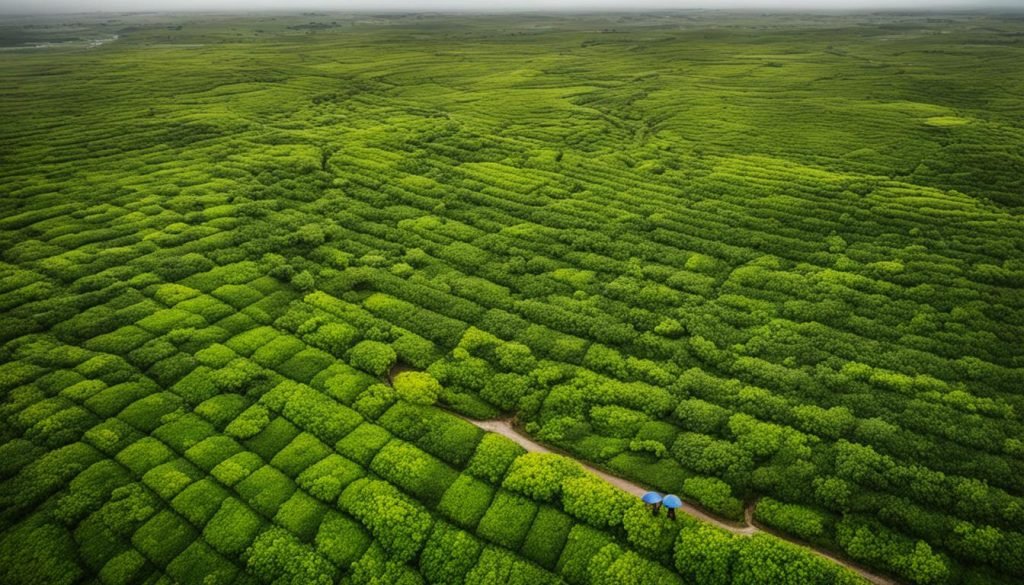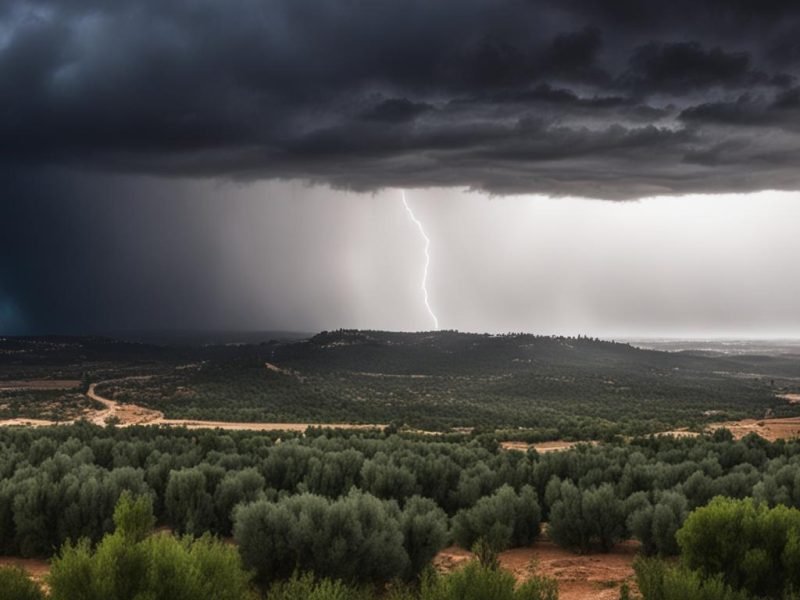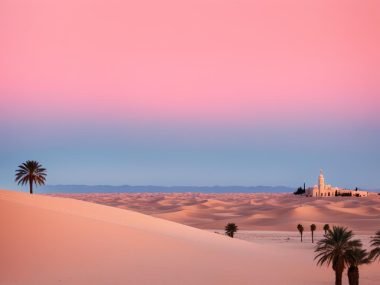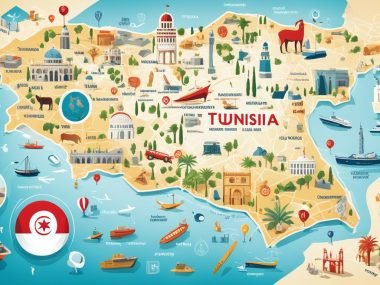Did you know Tunisia gets most of its rain in winter? If you’re visiting, knowing about the rainy season can make your trip better. Tunisia is in North Africa. Its weather changes from the coast to the inside. Near the sea, winters are mild and rainy, summers hot and sunny. But further in, it’s drier, even semi-desert or desert. The rainy season is like other places by the sea, with most rain in late autumn and winter.
Key Takeaways
- Tunisia’s winter months account for around 60% of its annual rainfall.
- Understanding locally specific rainfall patterns can enhance travel planning.
- The Mediterranean climate on Tunisia’s northern coast brings mild, rainy winters.
- Inland areas generally experience semi-desert or desert climates with minimal rain.
- The Tunisia rainfall statistics highlight the contrast between the coastal and inland regions.
Overview of Tunisia’s Climate
Tunisia has many different types of places, making its weather vary a lot. In the north, near the coast, the weather is quite mild in winter and very warm in summer. This coastal area gets enough rain, has moderate temperatures, and is very green.
However, as you go towards the south, it gets really dry. The middle and southern areas are very hot and hardly get any rain. These places are tough, but certain plants and animals can survive there.
The country also has mountains that make the weather different. In winter, these mountains can have snow. This adds to the special weather Tunisia has.
Also, Tunisia is the country in Africa that’s closest to Europe. This affects its weather, mixing Mediterranean and desert types. It’s very interesting to see how the weather changes from one place to another in Tunisia.
Seasonal Weather Patterns in Tunisia
Tunisia has different weather throughout the year. Knowing this can make your trip better.
Winter Weather Conditions
Winter in Tunisia is mild and a bit wet. In Tunis, temperatures are about 12.3°C in January. Even with cooler weather, there are sunny days. They are great for going out and looking around.
Summer Weather Conditions
Summer is hot and dry, especially away from the coast. The coast feels cooler because of the sea breeze. From July to September, there’s not much rain. This makes it good weather for swimming.
Autumn and Spring Climate
Autumn and spring have nicer temperatures and some rain. Months like April, May, and October are good for visits. Temperatures are usually under 30°C, making it comfortable for tourists.
Tunisia Rainy Season
The *rainy season* in Tunisia runs from late autumn to winter. The country gets more rain because of weather from the Mediterranean or Atlantic. During this time, it rains more often and a lot, changing the climate.

In Tunis, about 485 millimetres of rain fall each year, mostly from September to April. This is the best time to learn When Does It Rain In Tunisia? as it rains the most then. It’s very different from the dry summer.
Bizerte, in the far north, gets more rain. It sees about 650 millimetres of rain yearly. This gives a different view on When Does It Rain In Tunisia?. The weather here is very important for visitors and researchers.
| Location | Annual Rainfall (mm) | Rainy Season |
|---|---|---|
| Tunis | 485 | September-April |
| Bizerte | 650 | September-April |
The rain is different in these cities during the rainy season. Knowing When Does It Rain In Tunisia? is key for farming, handling water, and planning trips when it’s wet.
Tunisia Precipitation Data
In Tunisia, rainfall is not the same everywhere. Northern cities like Tunis get about 485 mm of rain a year. The further south you go, the less rain there is.
Take Sousse, for example. It’s on the coast and gets 300-400 mm of rain yearly. But in Gabès, which is even more to the south, they only see about 190 mm.
It’s drier in desert areas. Tozeur and El Borma get only 95 mm and 60 mm of rain a year, respectively.
| City | Average Annual Rainfall (mm) |
|---|---|
| Tunis | 485 |
| Sousse | 300-400 |
| Gabès | 190 |
| Tozeur | 95 |
| El Borma | 60 |
So, the rainfall in Tunisia changes a lot from place to place. Knowing this helps us understand the climate better. It’s also good to know when planning a trip there.
The Impact of the Mediterranean Climate
Tunisia’s Mediterranean climate greatly shapes its coastal weather. It deeply alters temperature and rainfall all year. This causes big changes in Tunisia’s weather.
Influence on Temperature
Tunisia’s coast has mild winters thanks to the Mediterranean climate. Daytime highs are usually between 16-18 °C. This makes it much warmer than many places. Summers get hot, with temperatures reaching 32-33 °C. This makes beach resorts very popular in summer.
Effect on Rainfall
The Mediterranean climate also changes when and how much it rains in Tunisia. Coastal areas see more rain, especially in late autumn and winter. Rainfall drops in late spring and summer. This pattern means a dry, hot summer but a wetter autumn and winter. It helps with farming and filling up water stores.
When Does It Rain In Tunisia?

The best time to go to Tunisia for rain is late autumn to winter. This is when it rains the most, from October to February. For some rain but also nice weather, try April, May, or October.
These months have short showers and warm days. It’s a good time for a trip. The rain makes Tunisia’s green areas look even better. Late autumn and early spring are great for visiting. The weather’s nice, and the views are fresh.
Regional Differences in Rainfall
Learning about Tunisia’s climate shows its varied weather. Each area has different rain patterns due to geography and the sea.
Northern Coast
The north coast, with Tunis, gets steady rain all year. Thanks to the Mediterranean climate, it’s wetter here. Bizerte sees the most rain out of these areas.
Eastern Coast
As you go south, rain drops. Sousse and Monastir have less wet days. Near the Gulf of Gabès, it gets even drier, showing the shift to desert.
Inland and Desert Areas
Inland and deserts, like Gafsa and Tozeur, get little rain. They’re much drier than the coast. Places like El Borma are very dry, underlining Tunisia’s varied weather.
Monthly Rainfall in Tunisia
Tunisia’s monthly rainfall is quite interesting. Each month shows different weather conditions.
In summer, some areas see hardly any rain, sometimes less than 1mm. But in winter, especially in the north, it rains a lot more.
| Month | Average Rainfall (mm) | Observation |
|---|---|---|
| January | 70mm | Significant rainfall observed, especially in the north |
| February | 55mm | Gradual decrease in precipitation |
| March | 50mm | Early signs of spring with consistent rainfall |
| April | 35mm | Rainfall begins to taper off |
| May | 20mm | Onset of drier conditions |
| June | 7mm | Minimal rainfall marking the dry season’s start |
| July | 3mm | The driest month observed |
| August | 5mm | Continued dry spell with sparse rain |
| September | 20mm | Incremental increase signaling autumn |
| October | 40mm | Autumnal rains return |
| November | 60mm | A noticeable rise in precipitation |
| December | 70mm | Peak winter rainfall observed |
This rainfall chart helps travellers plan their trips. They can enjoy Tunisia’s various weather.
Best Time to Visit Tunisia for Rain
Spring and autumn are great to visit Tunisia for rain. These seasons have cooler weather and a bit of rain. This makes the land beautiful and is perfect for those who like cooler weather.
Tourist Attractions During Rainy Seasons
In the rainy seasons, Tunisia’s sights are still open and look lovely. Beaches are quiet, good for walks. Also, places like Carthage and Dougga are less busy. This means you can enjoy them more.
Activities to Enjoy in Rainy Weather
Tunisia’s rainy days are full of fun things to do. There are cultural festivals in spring and autumn. Plus, the rain makes the countryside green, great for walks and hikes. These let you see the beauty of Tunisia in a fresh way.
So, visiting Tunisia when it rains is great. It offers lots of benefits and amazing experiences. This ensures a trip you’ll always remember.
Planning Your Trip Around Tunisia’s Weather
Planning a trip to Tunisia? It’s key to know the weather beforehand. This makes your trip smooth and fun. You might want to visit the lively coast or the desert. So, the weather will guide your plan.
Winters bring cold nights in the desert. Wear warm clothes to stay cozy. Summers are very hot. Choose light, airy clothes then.
Knowing the weather in Tunisia helps you get ready for fun activities. Near the sea, the weather is nice for beaches and sea adventures. But further in, you’ll need gear for rain or sun.
| Season | Climate | Recommended Clothing | Suggested Activities |
|---|---|---|---|
| Winter | Cool, especially in the desert at night | Warm attire, layered clothing | Desert tours, city sightseeing |
| Summer | Hot and dry | Lightweight, breathable clothes | Beach outings, coastal visits |
| Spring/Autumn | Mild and pleasant | Mixed-season gear | Hiking, historical site visits |
Plan your Tunisia trip with the weather in mind. This ensures a comfy and unforgettable visit. You’ll love Tunisia’s natural beauty and unique culture.
Conclusion
Tunisia’s weather is special and varies a lot. It’s great for any traveller. You can plan your trip based on what you like. The north has a nicer, colder climate for those who love green places. But the south is drier, perfect for desert lovers.
Looking at Tunisia’s weather through the year shows its variety. The north gets more rain, which is good for farms and nature trips. The east coast and inside areas are great for sunny outings and exploring historic sites. Knowing about the weather helps you pick the best time to visit.
Keeping in mind the different areas and rainy seasons makes your trip to Tunisia better. You can see ancient Carthage or explore the busy markets when it rains. Every part of Tunisia offers something special. It has a strong culture and natural beauty. Tunisia is amazing for history fans, nature lovers, or adventure seekers, at any time.
Source Links
- https://www.climatestotravel.com/climate/tunisia – Tunisia climate: average weather, temperature, rain
- https://www.thomascook.com/holidays/weather/tunisia/ – The Best Time of Year to go to Tunisia
- https://www.metoffice.gov.uk/weather/travel/holiday-weather/africa/tunisia – Tunisia weather







